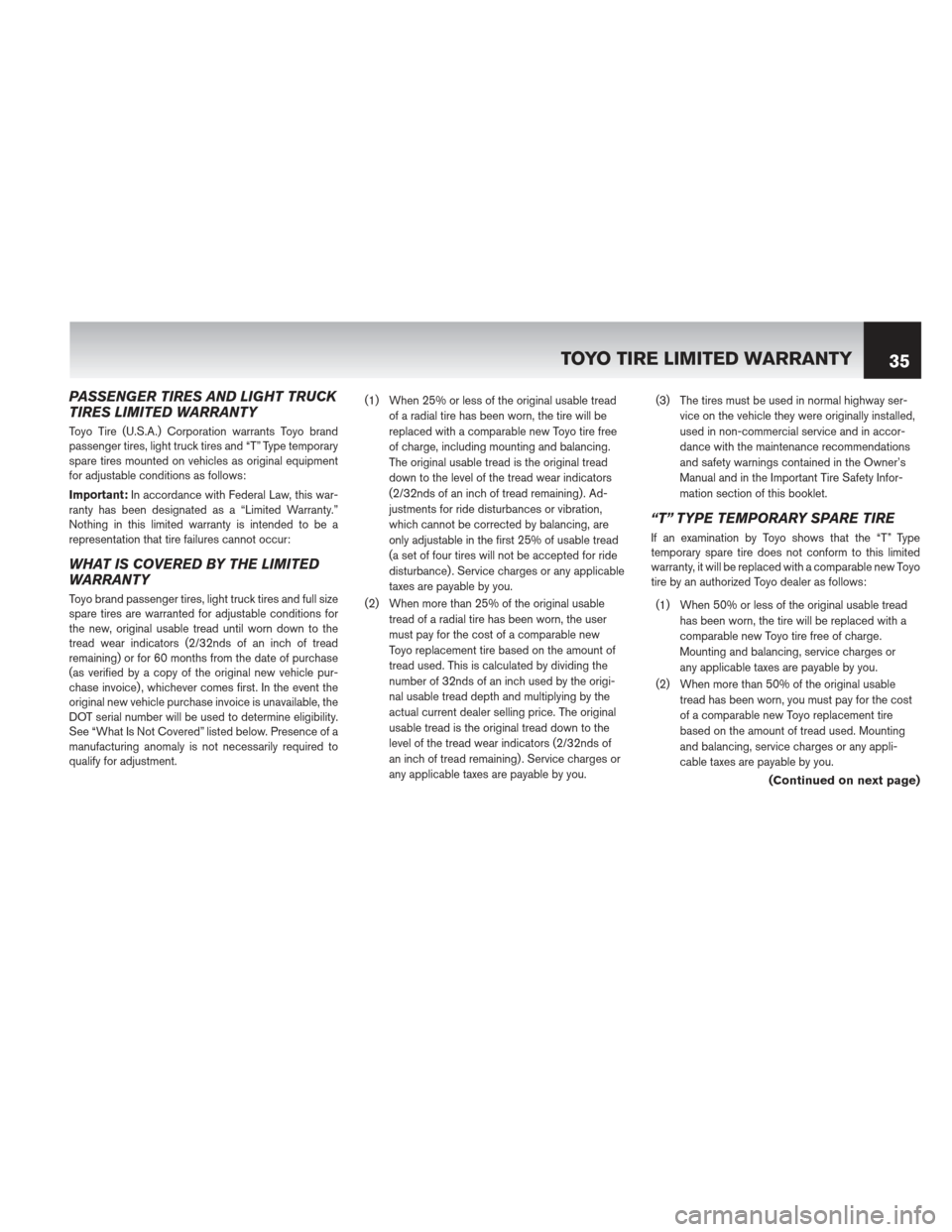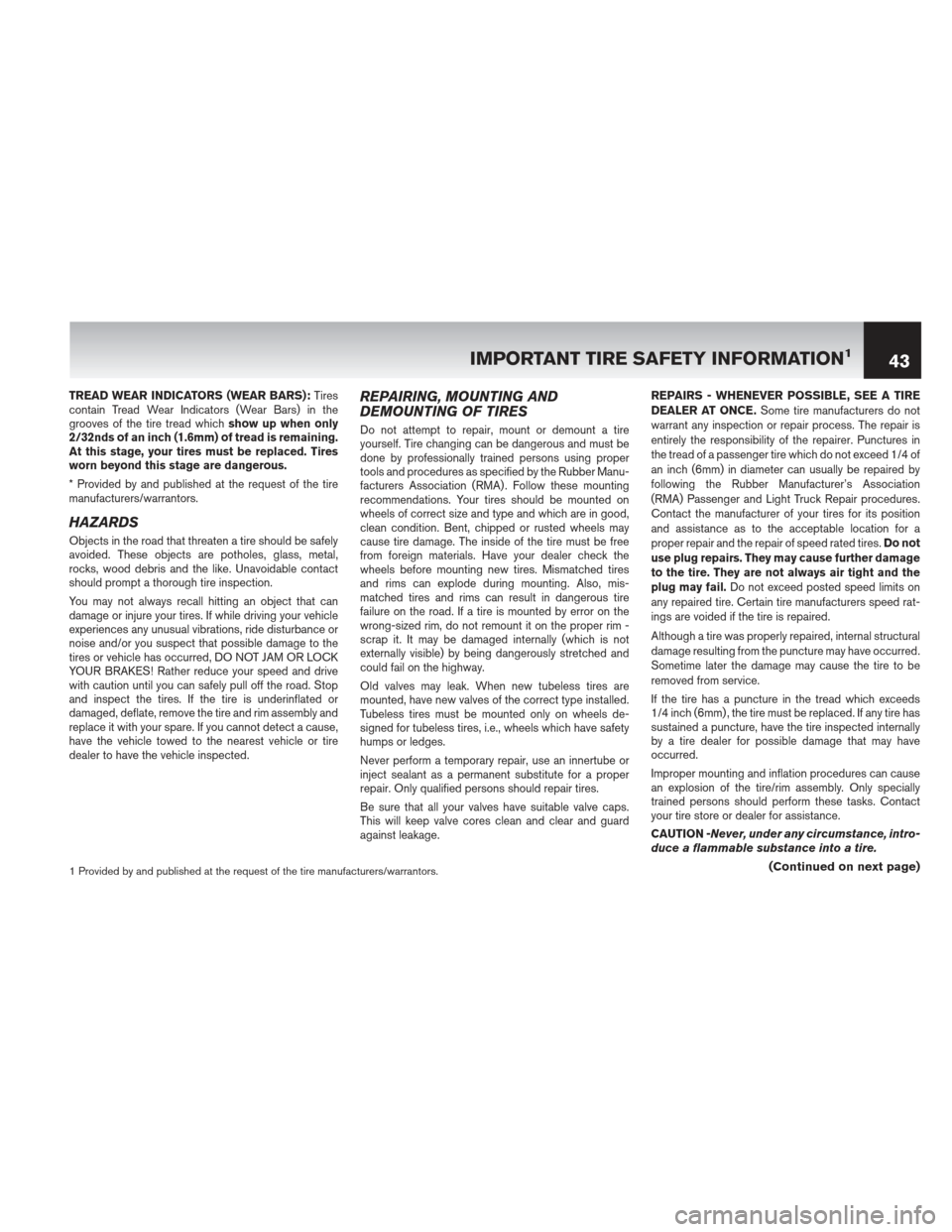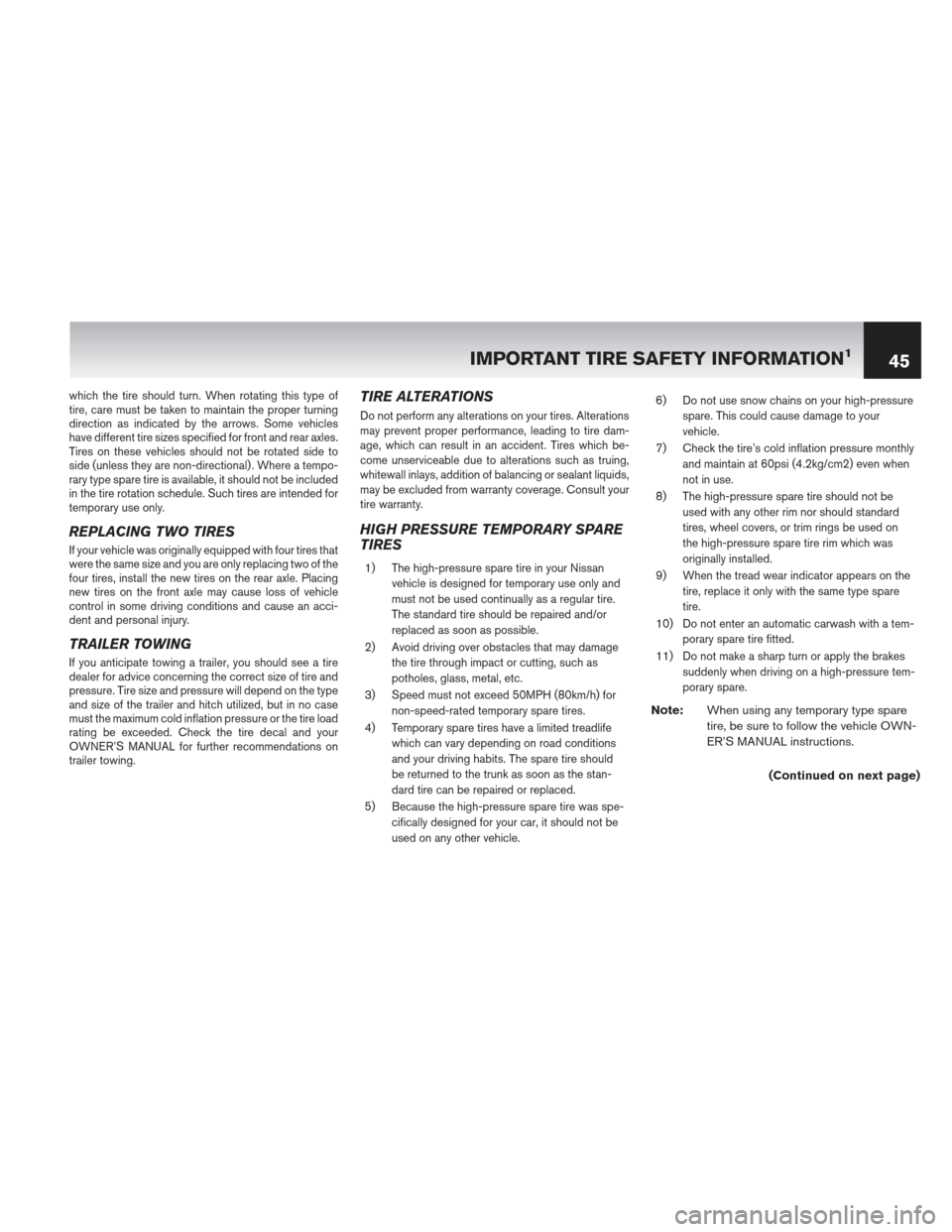2013 NISSAN GT-R service indicator
[x] Cancel search: service indicatorPage 38 of 61

PASSENGER TIRES AND LIGHT TRUCK
TIRES LIMITED WARRANTY
Toyo Tire (U.S.A.) Corporation warrants Toyo brand
passenger tires, light truck tires and “T” Type temporary
spare tires mounted on vehicles as original equipment
for adjustable conditions as follows:
Important:In accordance with Federal Law, this war-
ranty has been designated as a “Limited Warranty.”
Nothing in this limited warranty is intended to be a
representation that tire failures cannot occur:
WHAT IS COVERED BY THE LIMITED
WARRANTY
Toyo brand passenger tires, light truck tires and full size
spare tires are warranted for adjustable conditions for
the new, original usable tread until worn down to the
tread wear indicators (2/32nds of an inch of tread
remaining) or for 60 months from the date of purchase
(as verified by a copy of the original new vehicle pur-
chase invoice) , whichever comes first. In the event the
original new vehicle purchase invoice is unavailable, the
DOT serial number will be used to determine eligibility.
See “What Is Not Covered” listed below. Presence of a
manufacturing anomaly is not necessarily required to
qualify for adjustment. (1) When 25% or less of the original usable tread
of a radial tire has been worn, the tire will be
replaced with a comparable new Toyo tire free
of charge, including mounting and balancing.
The original usable tread is the original tread
down to the level of the tread wear indicators
(2/32nds of an inch of tread remaining) . Ad-
justments for ride disturbances or vibration,
which cannot be corrected by balancing, are
only adjustable in the first 25% of usable tread
(a set of four tires will not be accepted for ride
disturbance) . Service charges or any applicable
taxes are payable by you.
(2) When more than 25% of the original usable tread of a radial tire has been worn, the user
must pay for the cost of a comparable new
Toyo replacement tire based on the amount of
tread used. This is calculated by dividing the
number of 32nds of an inch used by the origi-
nal usable tread depth and multiplying by the
actual current dealer selling price. The original
usable tread is the original tread down to the
level of the tread wear indicators (2/32nds of
an inch of tread remaining) . Service charges or
any applicable taxes are payable by you. (3) The tires must be used in normal highway ser-
vice on the vehicle they were originally installed,
used in non-commercial service and in accor-
dance with the maintenance recommendations
and safety warnings contained in the Owner’s
Manual and in the Important Tire Safety Infor-
mation section of this booklet.
“T” TYPE TEMPORARY SPARE TIRE
If an examination by Toyo shows that the “T” Type
temporary spare tire does not conform to this limited
warranty, it will be replaced with a comparable new Toyo
tire by an authorized Toyo dealer as follows:
(1) When 50% or less of the original usable tread has been worn, the tire will be replaced with a
comparable new Toyo tire free of charge.
Mounting and balancing, service charges or
any applicable taxes are payable by you.
(2) When more than 50% of the original usable tread has been worn, you must pay for the cost
of a comparable new Toyo replacement tire
based on the amount of tread used. Mounting
and balancing, service charges or any appli-
cable taxes are payable by you.
(Continued on next page)
TOYO TIRE LIMITED WARRANTY 35
Page 46 of 61

TREAD WEAR INDICATORS (WEAR BARS):Tires
contain Tread Wear Indicators (Wear Bars) in the
grooves of the tire tread which show up when only
2/32nds of an inch (1.6mm) of tread is remaining.
At this stage, your tires must be replaced. Tires
worn beyond this stage are dangerous.
* Provided by and published at the request of the tire
manufacturers/warrantors.
HAZARDS
Objects in the road that threaten a tire should be safely
avoided. These objects are potholes, glass, metal,
rocks, wood debris and the like. Unavoidable contact
should prompt a thorough tire inspection.
You may not always recall hitting an object that can
damage or injure your tires. If while driving your vehicle
experiences any unusual vibrations, ride disturbance or
noise and/or you suspect that possible damage to the
tires or vehicle has occurred, DO NOT JAM OR LOCK
YOUR BRAKES! Rather reduce your speed and drive
with caution until you can safely pull off the road. Stop
and inspect the tires. If the tire is underinflated or
damaged, deflate, remove the tire and rim assembly and
replace it with your spare. If you cannot detect a cause,
have the vehicle towed to the nearest vehicle or tire
dealer to have the vehicle inspected.
REPAIRING, MOUNTING AND
DEMOUNTING OF TIRES
Do not attempt to repair, mount or demount a tire
yourself. Tire changing can be dangerous and must be
done by professionally trained persons using proper
tools and procedures as specified by the Rubber Manu-
facturers Association (RMA) . Follow these mounting
recommendations. Your tires should be mounted on
wheels of correct size and type and which are in good,
clean condition. Bent, chipped or rusted wheels may
cause tire damage. The inside of the tire must be free
from foreign materials. Have your dealer check the
wheels before mounting new tires. Mismatched tires
and rims can explode during mounting. Also, mis-
matched tires and rims can result in dangerous tire
failure on the road. If a tire is mounted by error on the
wrong-sized rim, do not remount it on the proper rim -
scrap it. It may be damaged internally (which is not
externally visible) by being dangerously stretched and
could fail on the highway.
Old valves may leak. When new tubeless tires are
mounted, have new valves of the correct type installed.
Tubeless tires must be mounted only on wheels de-
signed for tubeless tires, i.e., wheels which have safety
humps or ledges.
Never perform a temporary repair, use an innertube or
inject sealant as a permanent substitute for a proper
repair. Only qualified persons should repair tires.
Be sure that all your valves have suitable valve caps.
This will keep valve cores clean and clear and guard
against leakage. REPAIRS - WHENEVER POSSIBLE, SEE A TIRE
DEALER AT ONCE.
Some tire manufacturers do not
warrant any inspection or repair process. The repair is
entirely the responsibility of the repairer. Punctures in
the tread of a passenger tire which do not exceed 1/4 of
an inch (6mm) in diameter can usually be repaired by
following the Rubber Manufacturer’s Association
(RMA) Passenger and Light Truck Repair procedures.
Contact the manufacturer of your tires for its position
and assistance as to the acceptable location for a
proper repair and the repair of speed rated tires. Do not
use plug repairs. They may cause further damage
to the tire. They are not always air tight and the
plug may fail. Do not exceed posted speed limits on
any repaired tire. Certain tire manufacturers speed rat-
ings are voided if the tire is repaired.
Although a tire was properly repaired, internal structural
damage resulting from the puncture may have occurred.
Sometime later the damage may cause the tire to be
removed from service.
If the tire has a puncture in the tread which exceeds
1/4 inch (6mm) , the tire must be replaced. If any tire has
sustained a puncture, have the tire inspected internally
by a tire dealer for possible damage that may have
occurred.
Improper mounting and inflation procedures can cause
an explosion of the tire/rim assembly. Only specially
trained persons should perform these tasks. Contact
your tire store or dealer for assistance.
CAUTION -Never, under any circumstance, intro-
duce a flammable substance into a tire.
(Continued on next page)1 Provided by and published at the request of the tire manufacturers/warrantors.
IMPORTANT TIRE SAFETY INFORMATION143
Page 48 of 61

which the tire should turn. When rotating this type of
tire, care must be taken to maintain the proper turning
direction as indicated by the arrows. Some vehicles
have different tire sizes specified for front and rear axles.
Tires on these vehicles should not be rotated side to
side (unless they are non-directional) . Where a tempo-
rary type spare tire is available, it should not be included
in the tire rotation schedule. Such tires are intended for
temporary use only.
REPLACING TWO TIRES
If your vehicle was originally equipped with four tires that
were the same size and you are only replacing two of the
four tires, install the new tires on the rear axle. Placing
new tires on the front axle may cause loss of vehicle
control in some driving conditions and cause an acci-
dent and personal injury.
TRAILER TOWING
If you anticipate towing a trailer, you should see a tire
dealer for advice concerning the correct size of tire and
pressure. Tire size and pressure will depend on the type
and size of the trailer and hitch utilized, but in no case
must the maximum cold inflation pressure or the tire load
rating be exceeded. Check the tire decal and your
OWNER’S MANUAL for further recommendations on
trailer towing.
TIRE ALTERATIONS
Do not perform any alterations on your tires. Alterations
may prevent proper performance, leading to tire dam-
age, which can result in an accident. Tires which be-
come unserviceable due to alterations such as truing,
whitewall inlays, addition of balancing or sealant liquids,
may be excluded from warranty coverage. Consult your
tire warranty.
HIGH PRESSURE TEMPORARY SPARE
TIRES
1) The high-pressure spare tire in your Nissanvehicle is designed for temporary use only and
must not be used continually as a regular tire.
The standard tire should be repaired and/or
replaced as soon as possible.
2) Avoid driving over obstacles that may damage the tire through impact or cutting, such as
potholes, glass, metal, etc.
3) Speed must not exceed 50MPH (80km/h) for non-speed-rated temporary spare tires.
4) Temporary spare tires have a limited treadlife which can vary depending on road conditions
and your driving habits. The spare tire should
be returned to the trunk as soon as the stan-
dard tire can be repaired or replaced.
5) Because the high-pressure spare tire was spe- cifically designed for your car, it should not be
used on any other vehicle. 6) Do not use snow chains on your high-pressure
spare. This could cause damage to your
vehicle.
7) Check the tire’s cold inflation pressure monthly and maintain at 60psi (4.2kg/cm2) even when
not in use.
8) The high-pressure spare tire should not be used with any other rim nor should standard
tires, wheel covers, or trim rings be used on
the high-pressure spare tire rim which was
originally installed.
9) When the tread wear indicator appears on the tire, replace it only with the same type spare
tire.
10) Do not enter an automatic carwash with a tem- porary spare tire fitted.
11) Do not make a sharp turn or apply the brakes suddenly when driving on a high-pressure tem-
porary spare.
Note: When using any temporary type spare
tire, be sure to follow the vehicle OWN-
ER’S MANUAL instructions.
(Continued on next page)
IMPORTANT TIRE SAFETY INFORMATION145